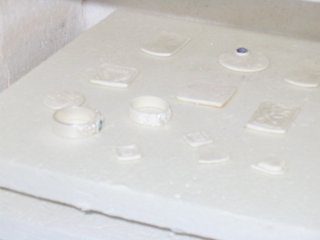 I began the day by falling down the stairs… for the second time this year. To me the term “slippers” refers not to being able to slip them on my feet, but to the slick soles. Rather than show The Internet the large bruise on my backside, I will post a photo of the roses my friend Claire gave me today “just because.” We spent this afternoon doing research (read: browsing jewelry magazines for inspiration).
I began the day by falling down the stairs… for the second time this year. To me the term “slippers” refers not to being able to slip them on my feet, but to the slick soles. Rather than show The Internet the large bruise on my backside, I will post a photo of the roses my friend Claire gave me today “just because.” We spent this afternoon doing research (read: browsing jewelry magazines for inspiration).
Tonight I am having a couple gals over to work with PMC. I haven’t worked with it much lately so this will be a good refresher for me.

